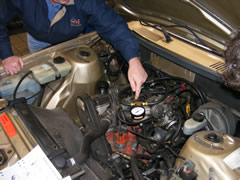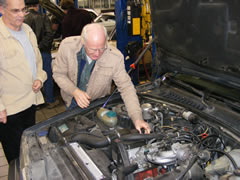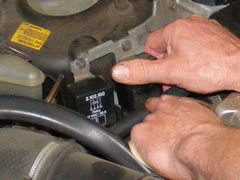My Car Won't Start
from our event held on
November 14, 2007
The 2007 edition of the Volvo Club of BC winter Technical Session was held on Wednesday, November 14, 2007. The people at Volvo of North Vancouver graciously opened their shop bay doors to host an informative and entertaining evening. Master technician Ian Peterkin demonstrated fault tracing techniques and explain the most likely causes for “non starting” of the 200, 700/900 and 850/S70 series. The big difference was that the Club members got to do the fault tracing after the instructions.
We will feature a full article here in the coming month. Meanwhile, members can review the handy fault-tracing guide that Ian prepared for us. You can find this in our newsletters section.
MapQuest directions.
It was another very useful and enjoyable technical session, and the fourth year in a row that we were able to use the service bay of the Volvo of North Vancouver Dealership. Many thanks to Parts and Service Manager, Mike Thompson, for letting us use the facility. Each year expert Volvo Technician, Ian Peterkin, has generously presented these technical sessions for us. We really appreciate his skill and his generosity in sharing his knowledge. This year he enlisted the assistance of Tony Do, a young Volvo Master Technician at the dealership.



23 club members showed up for the session and besides the education, they enjoyed a raffle for the numerous door prizes provided by Volvo of North Vancouver as well as a large tool kit supplied by Greg Wharry of Stanley/Proto tools.
This year’s session, "My Car Won’t Start", was intended to teach us some basic troubleshooting skills that could be applied in the event of being unable to get an engine started. We had three subject cars representing the 200,700/900 and 800series cars:
- Ryan Han’s 1993 244DL (B230F engine),
- Glenn Little’s 91 940SE (B230FT turbo), and
- 850
This year’s technical session was handled differently. Rather than simply watching and listening, Club members were able to jump right in and exercise their troubleshooting skills. Ian first gave us a brief introductory course, which lasted about a half-hour. He covered the basic systems of fuel, ignition and compression for these cars, explaining the routine for assessing problems and what faults we might likely find. Our contingent was then split into three teams, each one assigned to a previously disabled car mentioned above, with the expectation that each team would diagnose and correct the ailment that was causing the no-start problem. Phil Mijo lead the attack on the 240; Glenn Little leading the team on his 940 and the balance of the attendees on the newer 850.
We were given some trouble-shoot diagrams and a step-by-step guide, all of which are available to members on our web site.
Ian started the tutorial by reminding us that there are three basic requirements for an engine to run: fuel, ignition and compression. Old-school tended to start with fuel, but Ian’s preference is to look at ignition first. This is probably wise; with K-Jetronic systems the fuel pump relay is activated by impulses from the ignition system.
Start by looking for spark at the spark plug end of the ignition leads. Pull one lead off a spark plug and connect it to a loose spark plug. Hold the body of the plug on a part of the engine and have your assistance crank the engine over. A bright white to blue spark should be regularly visible in the plug gap. If there is no spark visible, move the test plug to the coil side of the distributor and redo the test. This will help rule out a fault in the distributor, likely a bad cap and rotor. If there is no spark visible at the coil, the next logical thing to test is the low-voltage power supply to the coil itself. Ian pointed out that a faulty coil is extremely rare, so much so that they may not even keep spares in stock.

We next moved on to the fuel system. Both the 940 and 240 had fairly standard and common Bosch LH Jetronic systems. This system makes use of a single fuel distributor rail running the length of the cylinder head and supplying fuel to the four injectors. There are two obvious items to check with the fuel system: fuel pressure at the rail and impulses to the injectors used to open them. The fuel rail will normally have in the vicinity of 300 kPa of pressure and should be present while running or during or even after cranking the engine over. On newer LH systems, the rail has a Schrader valve (similar to that on your tires) allowing for easy testing of fuel pressure. If the centre of the valve is depressed with a small tool, pressurized fuel should be emitted from the valve. Assuming that the injectors are supplied with pressurized fuel, they will deliver the fuel into the intake stream only when electrical pulses are delivered to the injectors. On the LH systems, a simple test light could be used to verify the presence of pulses. A nicer solution, one that will work with the newer systems such as that found on the 850, is a small and inexpensive LED test light. You should be able to find one make for Mack Tools or GM. Optionally, you could check at the tool counter of any of your favorite automotive parts and supply retail stores. This tool can be plugged into the injector electrical connector after first disconnecting the plug from an injector. Crank the engine over and watch for pulses of light from the LED.
A lack of fuel pressure almost certainly points to a faulty fuel pump, a fuel pump relay, or a fuse. In his experience, Ian told us that a fuel pump relay will typically last about tens years. Unfortunately, the fuel pump, being more expensive and harder to replace, has a wider range of expected life span. When asked whether there is any warning sign of an imminent pump failure, he did mention that they tend to get louder. I can speak from experience that pumps generally pick the most inopportune time and location to fail, for example on the freeway heading for a bridge. These pumps typically range in price starting from a few hundred dollars and going up.
The fuel pump relay can be found in a variety of locations, depending on the model and year. Earlier 240 relays are located near the steering column, above the clutch pedal, whereas later models are mounted on the passenger foot-well, between the ignition and fuel system control units. Fuel pump relays on 700 and 900 can be found in the vicinity of the fuse block, forward of the gear lever on all but the very oldest cars.
One potential method of checking for an inoperative tank pump is by disconnecting the fuse for the tank pump while the engine is running to see whether that makes any difference at all in the sound of the main pump. If the pump wasn’t working anyhow, then shutting the fuse off will not result in any change. Those of us who have owned an older 240 with the cylindrical, pointy fuses, know that they are a constant source of electrical trouble. It would be wise to simply replace any suspect fuses in advance of them causing troubles. You can tell when those poor fuses have had enough when they either show rings around the metal contacts where they connect with the fuse block, or those contacts are simply missing or broken.
Assuming fuel and ignition spark is available, the final item to check on a non-starting car is compression. The most likely cause of no compression is as a result of a broken timing belt, though other causes are possible. A compression gauge should reveal a combustion chamber peak pressure of about 180 PSI (about 1200 kPa) while cranking. Ideally, pressure should not vary by more than 25% between cylinders. A bad cylinder head gasket would not normally result in a no-starting engine, but will result in rough running. A leaking head gasket will also normally result in rising levels of coolant or bubbles in an un-capped coolant overflow tank.
In not every case is a non-starting car completely reproducible and consistent. There may be cases where the car fails to start only when the engine is hot and only after leaving it sit for a certain length of time. When an engine is shut off when hot, the temperature in the bay climbs as the source of cool air is reduced and the hot engine components warm up the air and all components in the engine bay. Ian refers to this as "heat soak". This can affect components such as the crankshaft position sensor, resulting in the engine failing to start when hot. At the other end of the spectrum is cold starting. In many cases, the result of failure to start when very cold is the engine temperature sensor used by the engine management system. A faulty sensor could, in theory, send a message that the engine is actually quite hot.
Challenge Results
Now, on with the fun part.
240
This car came equipped with a fuel pressure gauge in the engine bay. Some of us picked up on this clue immediately, suspecting some possible issue with the fuel system. Not surprisingly, this patient showed no signs of pressure when the engine was cranked over. Our trusty leader, Phil Mijo, lead his team to a successful conclusion that there was no fuel pump operation due to a blown fuse. In mere minutes they had this car purring nicely and ready to send the customer (Ryan Han) on his way. Hopefully, we remembered to take the pressure gauge off.
740

Glenn Little, the Club ringer, went straight to work on his own car in hopes that he would not have to take the bus home that night. This was actually an interesting fault. Firstly, the team checked the ignition and quickly determined that there was no spark present. However, the car had actually been set up with another problem, which brought about this secondary effect of no spark. The intention was to have the fault manifest itself in the form of no injector pulses, but much to our surprise, it took out the injector power and the ignition spark. The offending part was the injector power relay on the left strut tower. Apparently, this relay will commonly fail.
850
The 850 was found to have fuel but no spark. Spark was first tested at the #1 plug, then the coil, with no spark at either. DC was tested at the low voltage side of the coil and found to be missing. The associated fuse looked fine but was found to be open when checked with a meter. [Thanks, Rob. Due to the limitations (and possibly memory) of the author, we didn't have details on this trouble. You can't be more than one place at a time.]
